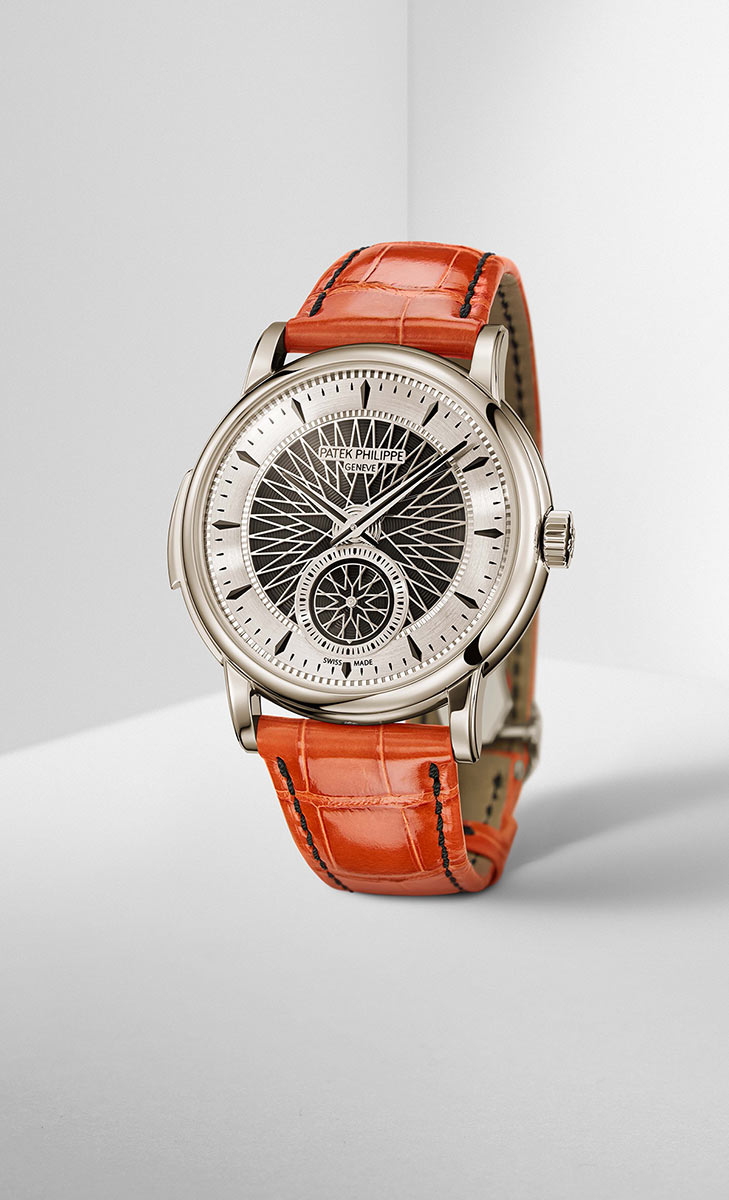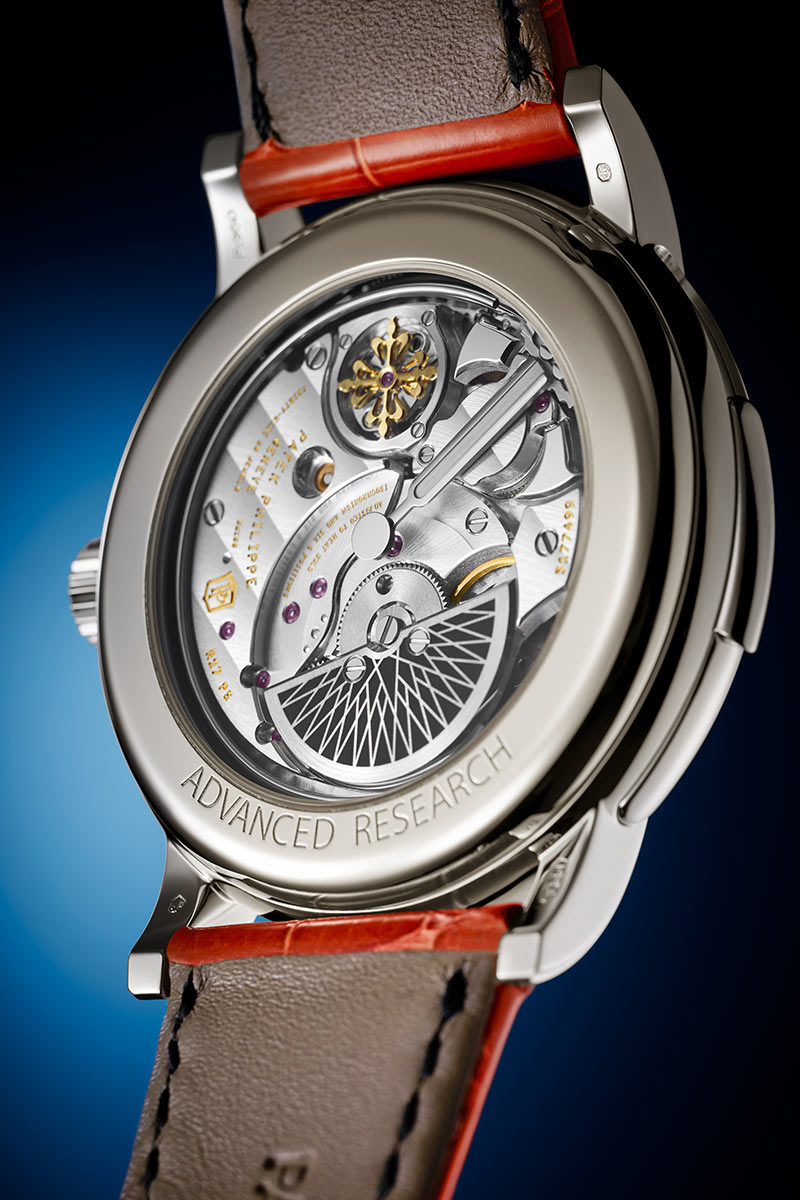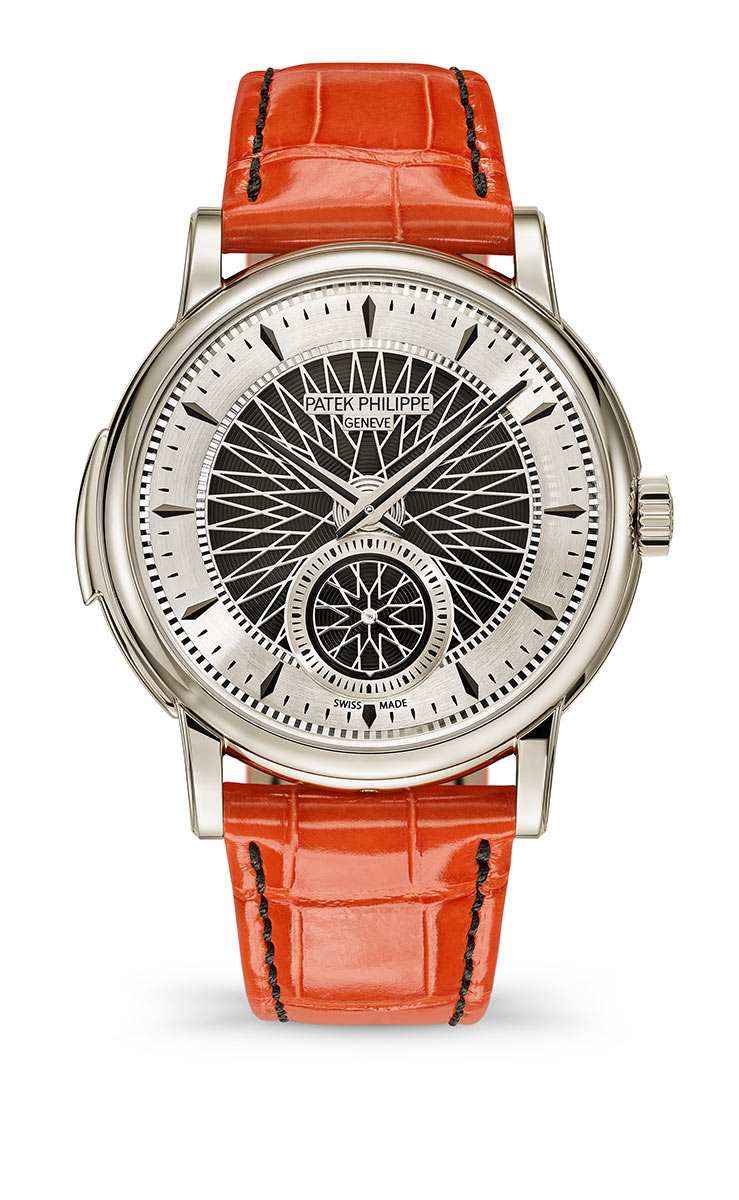Patek Philippe 5750P Advanced Research Fortissimo: the sound
Patek Philippe 5750P Advanced Research Fortissimo: the sound
Patek Philippe ”Advanced Research”
The manufacture presents a pioneering innovation for one of its most significant fields of competence – chiming watches.
The engineers at Patek Philippe “Advanced Research” have extended the horizon of its chiming watches by developing a totally new all-mechanical sound amplifying system. This fortissimo “ff” module consists of a flexibly suspended sound lever and an oscillating wafer made of transparent sapphire-crystal glass. In comparison with conventional minute repeaters and regardless of the case material, it delivers clearly amplified sound of excellent acoustic quality. Crowned by four patents, the pioneering technology is presented in the Ref. 5750 “Advanced Research” minute repeater, a special limited edition consisting of 15 watches cased in platinum and endowed with a unique dial design.

Patek Philippe 5750P Advanced Research Fortissimo: the sound
The spirit of innovation has been in Patek Philippe’s DNA since the company was founded. True to this uninterrupted tradition, the manufacture has spared no effort to further push the limits of watchmaking artistry and move at the forefront of technical development. But Patek Philippe considers innovations to be meaningful only if they offer the user genuine added value in terms of quality, precision, and dependability in the long run.Founded in 2005, the Patek Philippe “Advanced Research” department has meanwhile been integrated in the Research & Development division and vested with the task of pursuing high-end research in the fields of new materials, technologies, and conceptual fundamentals intended to open totally new perspectives in the domain of watchmaking.
To attain these objectives, the manufacture has established unique competencies, called together its best specialists, and provided them with the latest technical resources, including instruments required for computer simulation. The engineers at Patek Philippe “Advanced Research” also collaborate with independent external research facilities such as the Centre suisse d’électronique et de microtechnique de Neuchâtel (CSEM) or the Federal Institute of Technology Lausanne (EPFL).

Patek Philippe 5750P Advanced Research Fortissimo: the sound
Since 2005, Patek Philippe “Advanced Research” has stood out with pioneering work in the innovative field of Silinvar®, a derivative of silicon with phenomenal characteristics for watchmaking applications (temperature compensating, lightweight, lubricant-free, antimagnetic, etc.). Concurrently, the manufacture presented the first escape wheel in Silinvar® (2005), followed by the Spiromax® balance spring (2006), the Pulsomax® escapement (2008), the Oscillomax® ensemble (2011), and a further optimized version of the Spiromax® balance spring (2017). Each of these technology leaps was accompanied by the launch of a wristwatch in limited editions that were the first to be endowed with the innovative components. In the meantime, most of the movements for the current Patek Philippe watch collections are equipped with Spiromax® balance springs made of Silinvar.
In 2017, in a totally different field of research, Patek Philippe “Advanced Research” developed a compliant mechanism (system with flexible articulations) made of conventional horological steel that in Patek Philippe watches with two time zones is used to set the second time zone. This technical innovation was launched in the limited-edition watch that also first featured the optimized Spiromax® balance spring.
A sound amplification system with a sapphire-crystal oscillating wafer.
Today, the Patek Philippe “Advanced Research” department can present an important technical milestone in a domain that relates to the superb competencies of the manufacture: the chiming watches, or, more precisely, the minute repeaters. As regards these grand complications, Patek Philippe offers the largest portfolio of regularly produced models.Departing from the famous self-winding caliber R 27, the movement with which Patek Philippe in 1989 ushered in the grand comeback of the minute repeater, the engineers and designers at Patek Philippe “Advanced Research” searched for a way to amplify the volume of the time strike in a purely mechanical manner while preserving the excellent acoustic quality as well as the smallest possible dimensions. After several technical forays in various directions, they decided to preserve the design of the base movement and then on the bridge side (the side facing the wrist) to add a module that works like a mechanical loudspeaker. But unlike normal loudspeakers, the amplification of the sound does not rely on a flexible diaphragm which like the skin of a drum is attached along its periphery. Instead of a membrane, the system for which Patek Philippe registered three patents has an oscillating wafer made of synthetic sapphire with a thickness of 0.2 mm. Thanks to its angular motion, this rigid and freely movable wafer provides clearly better sound propagation for the confined volume of a wristwatch. The transparency of the sapphire glass also preserves the unobstructed view of the movement through the case back. To implement this heavily miniaturized system, the developers had to master considerable challenges, both in design and in production.
A flexibly suspended sound lever
To achieve sound transmission from the gongs of the minute repeater to the sapphire-glass oscillating wafer, the engineers developed a system with a steel sound lever that is attached in the middle of the oscillating wafer. The other end of this sound lever that resembles a tuning fork features a flexible attachment with a thickness of 0.08 mm. When the hammers strike the gongs, their oscillations are transmitted to the sound lever which in a first phase amplifies them and transmits them to the rigid oscillating wafer where they are further amplified. The angular motion of the oscillating wafer excites the air layers above and beneath the sapphire glass, producing a noticeably louder sound.

Patek Philippe 5750P Advanced Research Fortissimo: the sound
A new type of sound propagation
Parallel to the integration of the fortissimo “ff” amplifier module, the team also developed a totally new sound propagation system. In a classic minute repeater, the strikes of the hammers on the gongs create oscillations of the entire watch. The sound is propagated on all sides by the case, the back, and the crystal glass. Therefore, the case material has a significant influence on the sound, whereby rose gold is considered the best precious metal for sound propagation while platinum, with its higher material density, presents the greatest acoustic challenge. In the minute repeater with the fortissimo module, an insulation rim made of a high-tech composite material acoustically uncouples the amplifier from the movement. The sound is first routed to the sound lever and then to the oscillating wafer and subsequently propagated through four openings at 12, 3, 6, and 9 o’clock in a titanium ring. The sound waves exit through a narrow slot between the case back and the case band. A dust filter protects the movement without affecting the sound. So the case material does not influence the sound and its propagation. It is always of the same quality, regardless of whether the case material is rose, yellow, or white gold or platinum.

Patek Philippe 5750P Advanced Research Fortissimo: the sound
A distinctly louder and totally harmonious sound
The fortissimo module attached in the case back allows the sound to be heard at a six-fold larger distance. So a classic minute repeater on the wrist, at a distance of 10 m, sounds as loud and clear as an amplified minute repeater at a distance of 60 m. The manufacture also leveraged its rich experience in the domain of chiming watches to create a reverberating sound that also pleases the ear; this requires considerable dexterity and acute hearing. Even though the sound amplified by the fortissimo module differs slightly from that of other minute repeaters, it offers the harmonic quality and acoustic richness that underpin the unique reputation of Patek Philippe minute repeaters and arouse enthusiasm with a long resonant fade out relative to the “attack” (hardness). Additionally, the maximum duration of the time strike (32 strikes at 12:59) – it usually lasts 17 to 18 seconds – was extended to 20 to 21 seconds, allowing the gongs to fade somewhat longer.
Platinum components
Apart from the additional fortissimo module, the caliber R 27 PS benefits from further technical enhancements with respect to materials and design factors. The minute repeater hammers, originally in steel, were replaced with platinum hammers, a patented solution that in this specific case improves the quality of the strike in line with the directives of the Patek Philippe Seal and produces a softer strike as well without reducing its sonority. A minirotor in platinum replaces the eccentrically recessed minirotor in 22K gold; thanks to the greater material density, it delivers the same winding power with a thinner design. With it, the thickness of the fortissimo module can at least be partially offset.A limited edition of 15 watches
To present the exclusive system of sound amplification and propagation, Patek Philippe is launching a limited special edition of the watch as was the case previously with the “Advanced Research” innovations. The Ref. 5750P Patek Philippe “Advanced Research” minute repeater comes in a sleek case with a slightly domed bezel. It is inspired by the Ref. 5178 minute repeater with cathedral gongs, has the same diameter of 40 mm. However, with a height of 11.1 mm, it is 0.57 mm thicker. To demonstrate the efficiency of the fortissimo system, the manufacture opted for the material that poses the greatest acoustic challenges – 950 platinum.
In its center, the five-part elaborately constructed dial features an openworked motif inspired by the spoked wheels of vintage automobiles. It stands out against the black background with snailed spiraling lines. The subsidiary seconds at 6 o’clock consists of a rotating disc with the same openworked motif against a black snailed background and a small marker that serves as a hand – a movable element which creates a unique, dynamic effect. The time is indicated by flat Dauphine hands in white gold and applied kite-type hour markers in blackened white gold.
The sapphire-crystal case back reveals the hammers and the classic gongs of the minute repeater as well as the sound lever in the shape of a tuning fork that carries the transparent oscillating wafer of the fortissimo amplifier system. A pierced Calatrava cross decorates the cover of the centrifugal governor that assures the regular rhythm of the time strikes. The spectacular outlook also shows the Gyromax® balance spring in Silinvar® launched in 2006 by Patek Philippe “Advanced Research” as well as the large bridge with Geneva striping and carefully chamfered and polished edges. The platinum minirotor sports a ray pattern in the style of the dial; it was created with a laser-based light-absorbing surface texturing technique that allows certain segments to appear black. This limited special edition is worn on a shiny orange alligator strap with black contrast seams and a platinum fold-over clasp.
With its unique fortissimo “ff” system for sound amplification and propagation, Patek Philippe “Advanced Research” presents an innovation that will seduce all enthusiasts of minute repeaters and technical debuts. It opens up totally new horizons for chiming watches.
Patents
Loudspeaker with freely oscillating wafer:
PCT/EP2021/066501 – TIMEPIECE COMPONENT COMPRISING A SOUND AMPLIFICATION DEVICE
Sound amplification mechanism:
EP3812844 A1 – TIMEPIECE COMPONENT COMPRISING A SOUND AMPLIFICATION DEVICE
Platinum hammers:
CH00153/21 – STRIKEWORK MECHANISM COMPRISING A STRIKEWORK HAMMER AND A STRIKEWORK GONG, IN REFERENCE TO SAID STRIKEWORK HAMMER AND IN REFERENCE TO SAID STRIKEWORK GONG
Helical gongs with a coplanar attachment assure the balanced amplification of the hour and minute strikes
EP21203307.0 – BOSSED GONG ASSEMBLY FOR THE STRIKING MECHANISM OF A MOVEMENT









Leave a Reply
Want to join the discussion?Feel free to contribute!